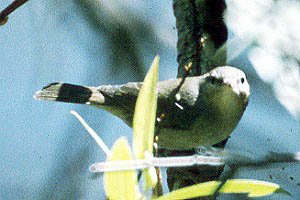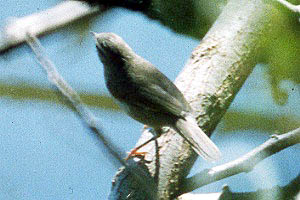Dusky Warbler
Antonelli's Pond, Santa Cruz Santa Cruz County, California
Thursday, October 16, 1997
Photos copyright © 1997 Bert McKee
 Today I drove down to Santa
Cruz hoping to see the Dusky Warbler (Phylloscopus fuscatus) which was apparently first found on Tuesday
by Steve Gerow, then seen again yesterday morning by Rick Fournier who alerted Don Roberson who saw the bird about
mid-day and confirmed the identification. Apparently it was also seen briefly late yesterday afternoon.
Today I drove down to Santa
Cruz hoping to see the Dusky Warbler (Phylloscopus fuscatus) which was apparently first found on Tuesday
by Steve Gerow, then seen again yesterday morning by Rick Fournier who alerted Don Roberson who saw the bird about
mid-day and confirmed the identification. Apparently it was also seen briefly late yesterday afternoon.
I arrived about 7:30am and about 75 people were congregated along the trail through the willows on the west
side of the pond but nobody saw the bird until Josiah Clark found it in willows across the pond on the east side
about 9:15am. Quite an exodus ensued. Eventually I got brief and incomplete views of the bird as it bathed and
preened deep in the shade of branches overhanging the water. Viewing was possible only from a very limited area
and relatively few birders were able to get into position at this time. Eventually the bird flew across the pond
to the southwest corner. We went around to the small beach near there and I got better and more complete views
but the light was miserable with the bird directly under the sun. It started calling and then flew back across
to the original location but we couldn't find it there. At this point it apparently flew across the pond again
to the large willow clumps on the west side of the pond and it was here that most of us got our best and most complete
views, and where David Nelson and Jim Lomax attempted photographs.
 The bird was a real skulker, spending
almost all of its time within two feet of the ground, mostly foraging on willow branches overhanging the water.
Its behavior was rather kinglet-like with some wing flicking and hover-gleaning. It called sporadically, a heavy
"tsick" sometimes doubled or in quick succession when alarmed. The loudness and intensity of this call
varied somewhat. The heaviest call reminded me of the call of Fox Sparrow, but more clipped and slightly higher.
Bert McKee suggested that the typical call sounded exactly like the secondary call of Lincoln's Sparrow and I think
that comes closest to accurately describing it. <Click here
to listen to Al Jaramillo's recording of the call-notes>
The bird was a real skulker, spending
almost all of its time within two feet of the ground, mostly foraging on willow branches overhanging the water.
Its behavior was rather kinglet-like with some wing flicking and hover-gleaning. It called sporadically, a heavy
"tsick" sometimes doubled or in quick succession when alarmed. The loudness and intensity of this call
varied somewhat. The heaviest call reminded me of the call of Fox Sparrow, but more clipped and slightly higher.
Bert McKee suggested that the typical call sounded exactly like the secondary call of Lincoln's Sparrow and I think
that comes closest to accurately describing it. <Click here
to listen to Al Jaramillo's recording of the call-notes>
The following description is based on notes taken just after seeing the bird, discussions with other observers
and memory:
A small brownish warbler-like bird with a bold well-marked supercilium and pale underparts.
The bill was very thin, relatively short and finely pointed. The base of the bill was wider than it was deep.
The upper mandible and tip of lower mandible were dark, but the basal 3/4ths of the lower mandible was strikingly
pinkish-orange in color. This color was difficult to see except at certain angles.
The crown, back and upperparts were relatively neutral wood-brown color, although the crown appeared slightly
grayer in certain light. Occasionally the upperparts had a decided greenish cast when seen in light filtered through
the green leaves, but I believe this was probably an artifact of lighting. A dark eye-line extended from the bill
through the dark eye across the top of the ear-coverts contrasting strongly with a long, prominent pale-buff supercilium.
The supercilium flared slightly behind the eye, but gradually tapered toward the nape, rather than being strongly
truncated toward the nape as in Arctic Warbler. The supercilium color seemed to be about the same pale buff color
throughout. I looked for a dark border to the upper part of the supercilium and did not see one. I also looked
to see if the front part of the supercilium blended toward the crown and it did not. It was as well defined in
front of the eye as behind. This helps eliminate Radde's Warbler (Phylloscopus schwarzi) and Yellow-streaked
Warbler (P. armandii). The latter two have a more massive, and more curved bill than Dusky, and they usually
show a dark border to the upper edge of the rear supercilium. The latter two can also be completely eliminated
by their very different call-notes; and neither has ever been recorded anywhere in North America.
The face was relatively pale with a dusky border to the ear coverts, and dull streaking inside this border.
The wing panel contrasted very little with the rest of the upperparts, although in certain light the edges of the
remiges appeared slightly grayer than the back. The primary projection was judged to be fairly long, but it was
difficult to tell where the primaries started and the secondaries ended as there was no contrast in coloration
between them. A prominent pale spot, outlined by dark appeared just below the bend of the wing near the alula recalling
the similar pattern on Orange-crowned Warbler (Vermivora celata).
The underparts were pale, somewhat dingy gray on the sides and in certain light showing a yellowish-buff cast
throughout. Palest areas were on the throat and belly. Faint grayish streaking could be seen on the sides of the
breast, almost connecting across the middle of the breast. Undertail coverts were light buff.
The tail was brown above, about the same color as the back, but became gradually darker near the tip and around
the outer webs of the outermost rectrices. The central tail feathers were slightly longer than the others, giving
the tail a slightly rounded appearance at times. Sometimes, the feathers bunched on each side resulting in a rounded
notch at the tip. Individual rectrices appeared slightly pointed at the tip.
The legs were dull pinkish, slightly brighter on the toes.
Although identification of warblers in this genus is notoriously difficult, this particular case was rather
straightforward. No field guides were consulted, but I did refer to Paul Leader's nicely illustrated paper on "Field
Identification of Dusky, Radde's and Yellow-streaked warblers" (Hong Kong Bird Report 1994: 170-180, Dec.
1995) which outlines the considerable individual variation present in Dusky Warbler.
This is the second Dusky Warbler I have ever seen. The first was at Hayward, Alameda County, 28 Sept 1984. In
that case I had the privilege of contributing to the identification process. The following is a list of previously
accepted records:
DUSKY WARBLER Phylloscopus fuscatus (5,5,0,0)
Accepted
1. 27 Sep 1980 SE Farallon I. SF
229-1980-5 (#CAS, ph.)
2. 28-29 Sep 1984 Hayward Reg. Shoreline ALA 216-1984-9
(ph.)
3. 14 Oct 1987 SE Farallon I. SF
6-1988-13 (ph.)
4. 22-23 Oct 1993 Goleta SBA
160-1993-19
5. 31 Oct-3 Nov 1995 Vandenburg AFB SBA
119-1995 (ph., tape)
In addition there has been one documented record from Kern County this year October 4-5; and a sighting of a
bird believed to possibly be this species in San Joaquin County October 3 of this year.
 Today's bird was viewed by
close to one hundred observers by the time I left. All appeared to agree with the identification.
Today's bird was viewed by
close to one hundred observers by the time I left. All appeared to agree with the identification.
I'd like to thank all those fine people who helped find the bird and keep it in view including some who sacrificed
their own views so others could see early on. This is the kind of situation that could have gotten out of control
and almost everybody was very careful not to push the bird or cause it unnecessary disturbance.
I also thought the discussions about identification were helpful and informative and I appreciated the astuteness
and sharpness of observation of the people with whom I had the privilege of sharing this sighting. I'd also like
to thank Karen Gilbert who selflessly lent me desperately needed note-paper at just the right time, and Dan Singer
who lent me his copy of the Hong Kong Bird Report even though he was unable to go see the bird today.
I'd especially like to thank Alvaro Jaramillo for making his recordings of the vocalizations available.
--
Joseph Morlan
380 Talbot Avenue #206
Pacifica, CA 94044
 Today I drove down to Santa
Cruz hoping to see the Dusky Warbler (Phylloscopus fuscatus) which was apparently first found on Tuesday
by Steve Gerow, then seen again yesterday morning by Rick Fournier who alerted Don Roberson who saw the bird about
mid-day and confirmed the identification. Apparently it was also seen briefly late yesterday afternoon.
Today I drove down to Santa
Cruz hoping to see the Dusky Warbler (Phylloscopus fuscatus) which was apparently first found on Tuesday
by Steve Gerow, then seen again yesterday morning by Rick Fournier who alerted Don Roberson who saw the bird about
mid-day and confirmed the identification. Apparently it was also seen briefly late yesterday afternoon. The bird was a real skulker, spending
almost all of its time within two feet of the ground, mostly foraging on willow branches overhanging the water.
Its behavior was rather kinglet-like with some wing flicking and hover-gleaning. It called sporadically, a heavy
"tsick" sometimes doubled or in quick succession when alarmed. The loudness and intensity of this call
varied somewhat. The heaviest call reminded me of the call of Fox Sparrow, but more clipped and slightly higher.
Bert McKee suggested that the typical call sounded exactly like the secondary call of Lincoln's Sparrow and I think
that comes closest to accurately describing it. <
The bird was a real skulker, spending
almost all of its time within two feet of the ground, mostly foraging on willow branches overhanging the water.
Its behavior was rather kinglet-like with some wing flicking and hover-gleaning. It called sporadically, a heavy
"tsick" sometimes doubled or in quick succession when alarmed. The loudness and intensity of this call
varied somewhat. The heaviest call reminded me of the call of Fox Sparrow, but more clipped and slightly higher.
Bert McKee suggested that the typical call sounded exactly like the secondary call of Lincoln's Sparrow and I think
that comes closest to accurately describing it. < Today's bird was viewed by
close to one hundred observers by the time I left. All appeared to agree with the identification.
Today's bird was viewed by
close to one hundred observers by the time I left. All appeared to agree with the identification.